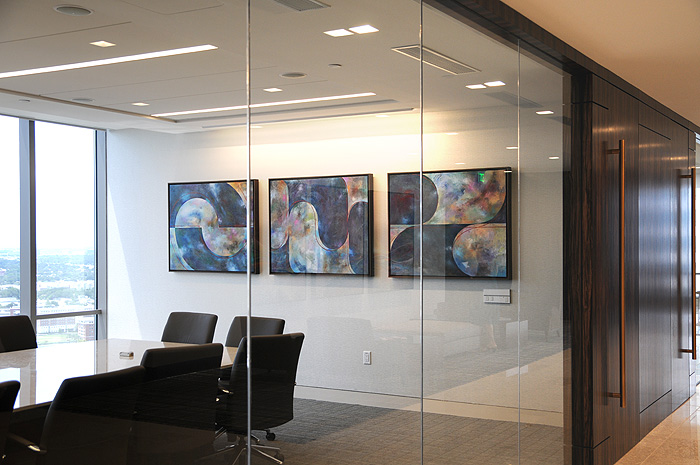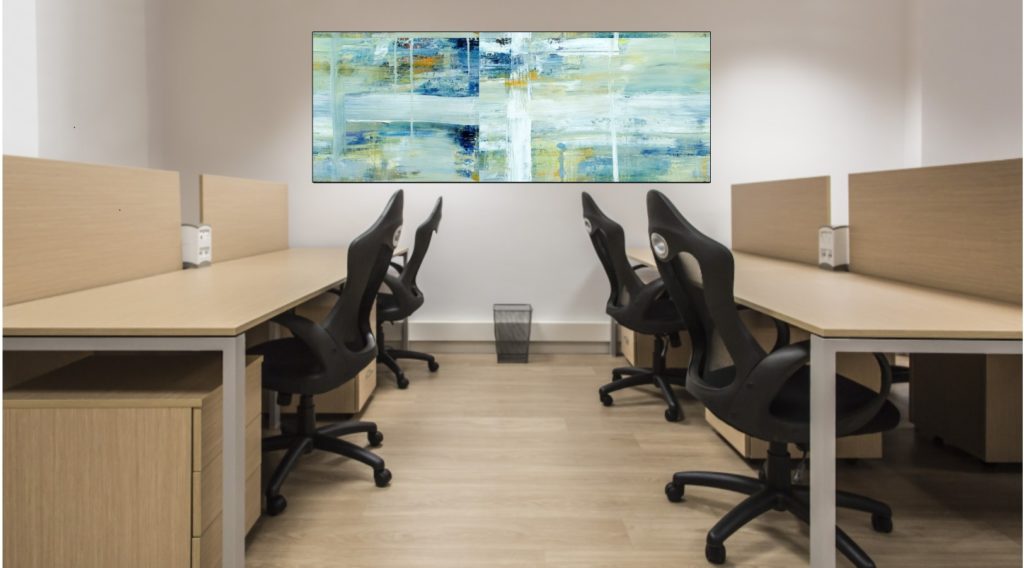Art in the Workplace

Art in the workplace is now taking on an important role. It is an increasingly important topic in both the design and investment sectors. As companies emerge from the crisis and the financial situation becomes more stable, they take the opportunity to improve the aesthetics of their workplaces by investing in projects and works of art.
The impact that art has on us is often underestimated. Colour patches in a painting hanging on the wall can affect the mood of a conference room, or an unusual work of art can be a point of conversation in a bland corporate space. Can art have a direct impact on employees’ productivity and well-being? It seems that the answer is „yes”.
The belief that art in the workplace is the only decorative was dispelled in a survey conducted among more than 800 employees who worked for 32 companies in the USA that hold art collections. The survey, in cooperation with the Business Committee for the Arts and the International Association for Professional Art Advisor, collected responses from companies, through distributors of various products, to law firms where the workplaces are located. It turned out that art in the workplace helps companies address key challenges such as reducing stress (for yes were -78%), increasing creativity (for yes – 64%) and encouraging expression (for yes -77%).
A survey at Cass Business School checked the perception of employees in the presence of art in the workplace and its impact on them, their clients or the company image.
Both men (64%) and women (73%) agreed that the appearance of their workplace affects their working day. Interestingly, male respondents not only rated art (39%) as one of the most important elements of interior design compared to other elements such as plants (39%) or the appearance of the reception desk (35%), but also gave art more importance as an element of interior design compared to the respondents.
Only 17% of women considered art to be a key element of interior design.
However, this impact on the individual employee’s work ethic, motivation, creativity, stress levels and general well-being seems to be greater for women than for men.
While 80% of men responded that art has little impact on work ethics, motivation; all respondents agreed that it yet has some impact on them. In particular, 54% of women admitted that art has a moderate impact on their creativity in the office (47% of men), and 80% of women agreed that art in the office can reduce their stress level (66% of men). In addition, 92% of women said that art has an impact on their general well-being, compared to 71% of men who do not notice it.
Distraction at work is not always a bad thing. If the object of your distraction is a work of art, it can actually increase productivity, reduce stress and increase well-being and inspire creativity. Instead of trying to artificially force people to be creative with inspiring slogans or stereotypical images, do invest in impressive pictures that stimulate discussion and encourage innovative thinking.
Looking at the screen all day long is a modern curse. With a reason to turn your eyes away and after a while to focus again, fatigue, headaches and the long-term effects of eyestrain are reduced.

Regular changes to what is on the walls in Your office will encourage people to take their eyes off the screen, change their field of vision and thus cleanse their eyes and mind, which gives a much needed relief.
Admiring the composition can also provide our brains with a certain distance from the task being performed, which, contrary to popular belief, is not necessarily a bad thing.
Research has shown that the dream mind is indeed very active, involved in a number of important mental processes. In other words, even when we think we are off, our brains do not slow down at all. Instead, they are busy at work, replenishing our reserves of mental and physical energy, which in turn increases productivity, adds energy, strengthens memories and encourages creativity – all important attributes in the world of work.
Research carried out by University of Exeter College of Psychology has shown that employees who can interfere in the way the place where they work is, are not only happier and healthier, but are also 32% more productive. More than 2,000 office workers took part in a series of studies on workplace attitudes and productivity.
But there were also further studies, one at the University of Exeter and another at commercial offices, where the participants performed a number of tasks in a workspace that was either:
STRICKT (simple and functional, containing only necessary elements),
DIVERSIFIED (decorated by the employer with plants and paintings),
PERSONALISED/DIVERSIFIED (allowing the employee to influence his or her environment),
IMPAIRED (the participants could organise the art and plants themselves – but the employer then returned to the enriched system).
This study showed that people working in diversified spaces (decorated with art or plants) were 17% more productive than those in aesthetically poor places and had less health problems. This number doubled for people who worked in personalized spaces.
As for those who saw the questioning of their personal ideas concerning the
appearance of the office – impaired space – their productivity levels were the same as those in the strict space.
„There is a real tendency to organise sterile, cost effective office spaces designed to encourage staff to continue working without distractions,” explains Research Director Dr Craig Knight. But there is no scientific area in the world that believes that this approach increases productivity or makes employees happier. As Knight says: „If you enrich space, people feel much happier and act better; a very good way to do that is to use art. „
This is certainly the philosophy that Deutsche Bank is dealing with. The German investment bank has the largest collection of corporate art in the world, with about 60,000 artworks in 900 offices in 40 countries. The bank, for its employees, also organises meetings and talks with artists.
„It’s not often that bankers talk to artists,” says Friedhelm Hütte, global head of art at Deutsche Bank. ” Art offers a window on social, political and economic aesthetics around the world, making it a good inspiration for our business, as we are still in the process of developing new ideas for our customers and responding to what is happening in the world”. The bank likes to buy works from contemporary artists, focusing on original paintings, graphics and photographs. „We like innovative and spontaneous things that capture the moment when an idea becomes visible.” – explains Hütte.
Art is increasingly seen as a medium that helps to create better brand recognition. It can help to tell the story of a company: who they are, what they do and what they value.
Art can contribute to the strengthening or introduction of new cultural values that guide the owners of a company, and this influences the sense of pride in the place where we work and the recognition of the community in which we live.

Essentially, the aim of art in any situation is to create an aesthetic environment. It stimulates the senses and makes people feel good. Through art, an employer communicates with his employees: „we care about the working environment” or „we want to do something to create a nice place for you to come to eagerly”. This is important to you and therefore important to us. We value you enough to invest in your environment.
Cultivation innovation and fresh thinking has never been more essential to being competitive, fueling growth and staying happy and productive workforce. Thoughtful and „human” places work help professionals in providing innovative plans, ideas and business solution.
If then you want your company to succeed, plan your business budget today so that it also includes funds for art.